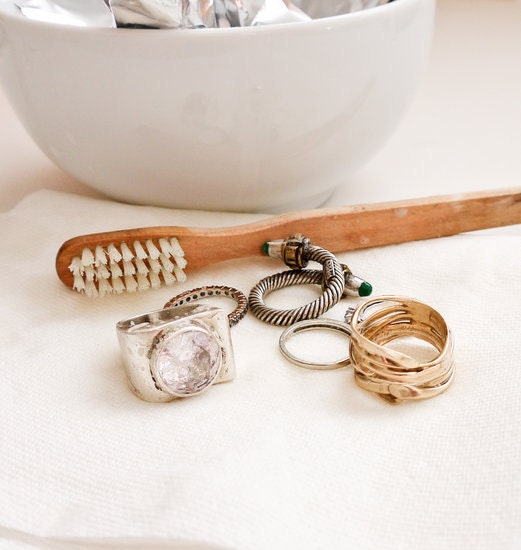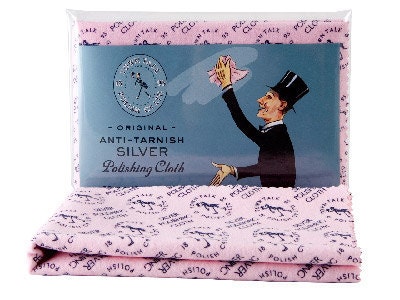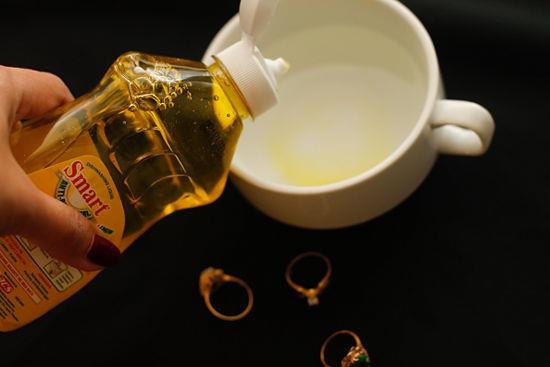I'm often asked how to clean jewellery, particularly diamond rings and stone set jewellery. When jewellery is worn next to the skin, it will become covered and clogged in oily debris mainly composed of dead skin, soap and grease. Dust and grit become lodged in this. Wearing rings while washing up can also allow a greasy film to coat the backs of stones, and the inside of settings. The main purpose of cleaning jewellery is to remove all this greasy debris.

A silver cloth that has polishing compound infused into it is also a great way to keep your jewellery nice and bright after cleaning.

1) Just get a cup of hot, not boiling water & add a teaspoon of washing up detergent. Let the piece soak for 10mins
2) To remove caked-on grease and other dirt from the backs of stones and crevices in chains, bracelets etc, I recommend an old toothbrush and warm soapy water. You can really get into the parts where dirt is lodged.
3) Rinse thoroughly and pat dry. Right after cleaning is a very common time to discover that stones are missing. Occasionally careless cleaning can be the cause, but usually wear and tear over a period of time are the real cause, and the cleaning merely appears to be the cause. Damage and trauma to jewellery can occur in everyday use, and sometimes the stones are only held in their settings by a build up of grease. When this is removed by cleaning, the stones drop out.
Literally, dirt and grease were the only things holding the stones in place!
Gold Jewellery
Most gold jewellery can be cleaned in warm soapy water, and can be gently brushed if necessary using an old tooth brush.
Gold Alloys
High carat alloys such as 18 carat and above, will not usually become tarnished
Diamonds
Diamonds are almost impossible to damage, the only precaution which should be observed is to avoid two diamonds rubbing together during cleaning, as they can scratch and cause abrasion to each other.Reasonable care should be taken not to catch diamond settings with filaments of thread, particularly strong synthetic threads which may bend claws, and loosen the stones they are meant to be securing.
Proprietary Jewellery Cleaner
Most jewellers now sell tubs of "Jewellery Cleaner". Although it will clean your jewellery, it will not necessarily work any better than the warm soapy water method I recommend above.
Ultrasonic Cleaners
Jewellery manufacturers and workshops use ultrasonic cleaning tanks. In these, the actual cleaning is performed by the cleaning solution, usually a mixture of ammonia and detergent, the ultrasonics merely provide the agitation to speed up the process. Small domestic ultrasonic cleaners are now available, and many jewellery stores sell them as gift items. We are not convinced that they work better than soap and water.
Repolishing
If jewellery with polished surfaces becomes matt and dull over long periods of wear, it can usually be repolished, but we believe that this is not really necessary. (unless it looks terrible!) Items like wedding rings are bound to become scratched, but I believe that, particularly with high carat golds and platinum, the intrinsic colour of the metal retains its beauty even when scratched and worn.
Gemstone Settings
It is advisable to avoid cleaning stone-set jewellery in a hand-basin or sink. If stones become loose in cleaning, they can easily become lost down the drain.
Jewellers Get the Blame!
Jewellers are frequently blamed wrongly for dislodging stones when jewellery items are repaired. Often, it will be the first time the jewellery has been cleaned since it was purchased, and it may need cleaning before it can be thoroughly examined to determine what work is needed. It will be further cleaned, sometimes several times during repair work. Even non-intrusive work, such as appraisal for valuation, usually require that the jewellery be cleaned first. I recently had an opal ring in for repair, and it was all held together with glue!!
Good old fashioned washing up detergent and a used toothbrush will breathe life back into your pieces!!

